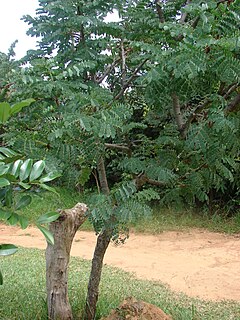The Pennsylvanian is, in the ICS geologic timescale, the younger of two subperiods of the Carboniferous Period. It lasted from roughly 323.2 million years ago to 298.9 million years ago. As with most other geochronologic units, the rock beds that define the Pennsylvanian are well identified, but the exact date of the start and end are uncertain by a few hundred thousand years. The Pennsylvanian is named after the U.S. state of Pennsylvania, where the coal-productive beds of this age are widespread.

In geometry, two figures or objects are congruent if they have the same shape and size, or if one has the same shape and size as the mirror image of the other.

Boa Esperança is a Brazilian municipality from the state of Minas Gerais. The municipality is located by the Serra da Boa Esperança, which became celebrated through song that brings its name, compounded by Lamartine Babo and performed by several singers. Across its territory passes Rio Grande, important to the development of the region. The economy of Boa Esperança is based on coffee plantations and tourism.

UTC−03:00 is an identifier for a time offset from UTC of −03:00.
This article is an index of Lists of ISO 639 codes. ISO 639 is a set of standards by the International Organization for Standardization that is concerned with representation of names for languages and language groups. The lists are:
The FIS Freestyle World Ski Championships is the world championship organized by the FIS for freestyle skiing. It was first organized in 1986 and is now held every odd year. Currently, the events included in the world championships are Moguls, Dual Moguls, Aerials, Ski cross, Slopestyle and Half-pipe. Formerly, Acroski and a combined event were held.
Vachellia nilotica subsp. adstringens is a perennial tree. It is not listed as being threatened. Some common names for it are cassie, piquants blancs and piquant lulu. Its geographic distribution includes Africa, Asia, the Indian Ocean area and the Middle East.
Stryphnodendron harbesonii is a species of flowering plant in the family Fabaceae. It occurs in areas of lowland forest up to 150 m. It is found only in the Philippines. It is threatened by habitat loss.

Stryphnodendron is a genus of flowering plant in the family Fabaceae. It belongs to the mimosoid clade of the subfamily Caesalpinioideae.
Stryphnodendron porcatum is a species of flowering plant in the family Fabaceae. It is found only in Ecuador. Its natural habitats are subtropical or tropical moist lowland forests and subtropical or tropical moist montane forests.

Elections to Preston City Council took place on 1 May 2008.

Jalapão State Park is a state park in the microregion of Jalapão in eastern Tocantins, Brazil. It contains a variety of landscapes including cerrado vegetation, sand dunes and flat-topped plateaus.
The molecular formula C15H11O6 (C15H11O6+, molar mass: 287.24 g/mol, exact mass: 287.0555626 u) may refer to:

Robinetinidol is a flavanol, a type of flavonoids.
Prorobinetidins are a type of condensed tannins formed from robinetinidol. They form robinetinidin when depolymerized under oxidative conditions.

Stryphnodendron adstringens is a species of legume in the genus Stryphnodendron found in Brazil.
Elections to Preston City Council took place on 3 May 2012, the same day as other 2012 United Kingdom local elections.

Amphipterygium adstringens, the cuachalalate is an ancient medicinal plant that has been commercially used in Mexico for centuries. Because of its ever-growing popularity and since the most sought after part of the plant is its bark, the cuachalalate was as of 2004 considered an endangered species. The Amphipterygium adstringens tree's height ranges from 4–8.5 m high. The distinguishing factor of this tree is its bark. Its bark is wrinkled, grayish in color and verrucose, with corky protuberances. Its branches are usually covered with scars of fallen leaves and may be bare or covered with fine hair-like structures. Its leave arrangements is imparipinnate with petioles that average 5.4 cm in length. It usually has 3-7 leaflets leaf. These leaflets have a cuneate base and an obtuse or rounded apex, its margin is dentate or crenate. A. adstringens can be differentiated from the other members of the Amphipterygium genus by the shape of its terminal leaflets, which is spathulate, and has dentate margins on the distal half of the leaflet.
Holcocera cerradicola is a moth in the family Blastobasidae. It is found in the Brazilian cerrado in Paraná.








